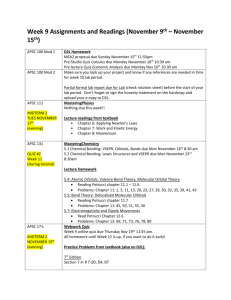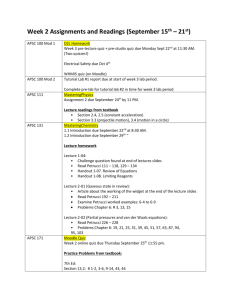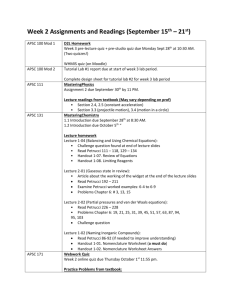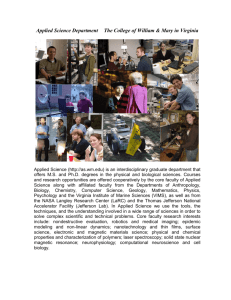Applied Science
advertisement
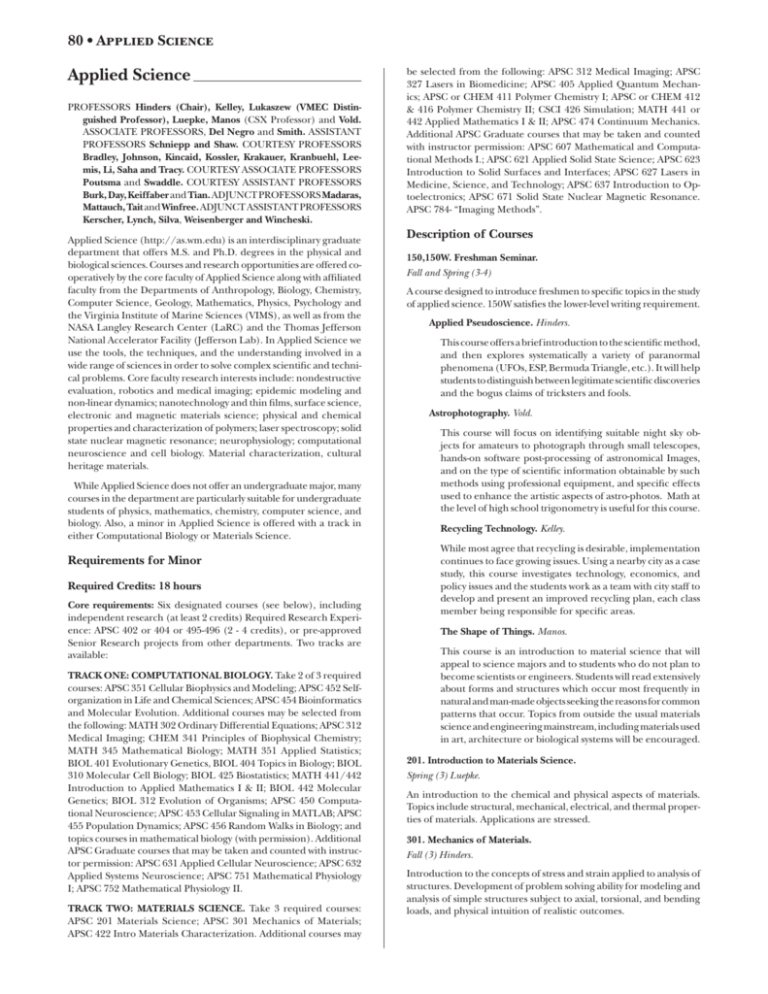
80 • Applied Science Applied Science PROFESSORS Hinders (Chair), Kelley, Lukaszew (VMEC Distinguished Professor), Luepke, Manos (CSX Professor) and Vold. ASSOCIATE PROFESSORS, Del Negro and Smith. ASSISTANT PROFESSORS Schniepp and Shaw. COURTESY PROFESSORS Bradley, Johnson, Kincaid, Kossler, Krakauer, Kranbuehl, Leemis, Li, Saha and Tracy. COURTESY ASSOCIATE PROFESSORS Poutsma and Swaddle. COURTESY ASSISTANT PROFESSORS Burk, Day, Keiffaber and Tian. ADJUNCT PROFESSORS Madaras, Mattauch, Tait and Winfree. ADJUNCT ASSISTANT PROFESSORS Kerscher, Lynch, Silva, Weisenberger and Wincheski. Applied Science (http://as.wm.edu) is an interdisciplinary graduate department that offers M.S. and Ph.D. degrees in the physical and biological sciences. Courses and research opportunities are offered cooperatively by the core faculty of Applied Science along with affiliated faculty from the Departments of Anthropology, Biology, Chemistry, Computer Science, Geology, Mathematics, Physics, Psychology and the Virginia Institute of Marine Sciences (VIMS), as well as from the NASA Langley Research Center (LaRC) and the Thomas Jefferson National Accelerator Facility (Jefferson Lab). In Applied Science we use the tools, the techniques, and the understanding involved in a wide range of sciences in order to solve complex scientific and technical problems. Core faculty research interests include: nondestructive evaluation, robotics and medical imaging; epidemic modeling and non-linear dynamics; nanotechnology and thin films, surface science, electronic and magnetic materials science; physical and chemical properties and characterization of polymers; laser spectroscopy; solid state nuclear magnetic resonance; neurophysiology; computational neuroscience and cell biology. Material characterization, cultural heritage materials. While Applied Science does not offer an undergraduate major, many courses in the department are particularly suitable for undergraduate students of physics, mathematics, chemistry, computer science, and biology. Also, a minor in Applied Science is offered with a track in either Computational Biology or Materials Science. Requirements for Minor Required Credits: 18 hours Core requirements: Six designated courses (see below), including independent research (at least 2 credits) Required Research Experience: APSC 402 or 404 or 495-496 (2 - 4 credits), or pre-approved Senior Research projects from other departments. Two tracks are available: TRACK ONE: COMPUTATIONAL BIOLOGY. Take 2 of 3 required courses: APSC 351 Cellular Biophysics and Modeling; APSC 452 Selforganization in Life and Chemical Sciences; APSC 454 Bioinformatics and Molecular Evolution. Additional courses may be selected from the following: MATH 302 Ordinary Differential Equations; APSC 312 Medical Imaging; CHEM 341 Principles of Biophysical Chemistry; MATH 345 Mathematical Biology; MATH 351 Applied Statistics; BIOL 401 Evolutionary Genetics, BIOL 404 Topics in Biology; BIOL 310 Molecular Cell Biology; BIOL 425 Biostatistics; MATH 441/442 Introduction to Applied Mathematics I & II; BIOL 442 Molecular Genetics; BIOL 312 Evolution of Organisms; APSC 450 Computational Neuroscience; APSC 453 Cellular Signaling in MATLAB; APSC 455 Population Dynamics; APSC 456 Random Walks in Biology; and topics courses in mathematical biology (with permission). Additional APSC Graduate courses that may be taken and counted with instructor permission: APSC 631 Applied Cellular Neuroscience; APSC 632 Applied Systems Neuroscience; APSC 751 Mathematical Physiology I; APSC 752 Mathematical Physiology II. TRACK TWO: MATERIALS SCIENCE. Take 3 required courses: APSC 201 Materials Science; APSC 301 Mechanics of Materials; APSC 422 Intro Materials Characterization. Additional courses may be selected from the following: APSC 312 Medical Imaging; APSC 327 Lasers in Biomedicine; APSC 405 Applied Quantum Mechanics; APSC or CHEM 411 Polymer Chemistry I; APSC or CHEM 412 & 416 Polymer Chemistry II; CSCI 426 Simulation; MATH 441 or 442 Applied Mathematics I & II; APSC 474 Continuum Mechanics. Additional APSC Graduate courses that may be taken and counted with instructor permission: APSC 607 Mathematical and Computational Methods I.; APSC 621 Applied Solid State Science; APSC 623 Introduction to Solid Surfaces and Interfaces; APSC 627 Lasers in Medicine, Science, and Technology; APSC 637 Introduction to Optoelectronics; APSC 671 Solid State Nuclear Magnetic Resonance. APSC 784- “Imaging Methods”. Description of Courses 150,150W. Freshman Seminar. Fall and Spring (3-4) A course designed to introduce freshmen to specific topics in the study of applied science. 150W satisfies the lower-level writing requirement. Applied Pseudoscience. Hinders. This course offers a brief introduction to the scientific method, and then explores systematically a variety of paranormal phenomena (UFOs, ESP, Bermuda Triangle, etc.). It will help students to distinguish between legitimate scientific discoveries and the bogus claims of tricksters and fools. Astrophotography. Vold. This course will focus on identifying suitable night sky objects for amateurs to photograph through small telescopes, hands-on software post-processing of astronomical Images, and on the type of scientific information obtainable by such methods using professional equipment, and specific effects used to enhance the artistic aspects of astro-photos. Math at the level of high school trigonometry is useful for this course. Recycling Technology. Kelley. While most agree that recycling is desirable, implementation continues to face growing issues. Using a nearby city as a case study, this course investigates technology, economics, and policy issues and the students work as a team with city staff to develop and present an improved recycling plan, each class member being responsible for specific areas. The Shape of Things. Manos. This course is an introduction to material science that will appeal to science majors and to students who do not plan to become scientists or engineers. Students will read extensively about forms and structures which occur most frequently in natural and man-made objects seeking the reasons for common patterns that occur. Topics from outside the usual materials science and engineering mainstream, including materials used in art, architecture or biological systems will be encouraged. 201. Introduction to Materials Science. Spring (3) Luepke. An introduction to the chemical and physical aspects of materials. Topics include structural, mechanical, electrical, and thermal properties of materials. Applications are stressed. 301. Mechanics of Materials. Fall (3) Hinders. Introduction to the concepts of stress and strain applied to analysis of structures. Development of problem solving ability for modeling and analysis of simple structures subject to axial, torsional, and bending loads, and physical intuition of realistic outcomes. Applied Science • 81 312. Medical Imaging. Spring (3) Hinders. Prerequisites: PHYS 101/102 or PHYS 107/108. 431. Applied Cellular Neuroscience. Fall (3) Del Negro. Prerequisite BIOL 345. Introduction to the modern clinical non-invasive diagnostic imaging techniques. The course will cover the physical, mathematical and computational principles of x-ray, ultrasound, radionuclide and magnetic resonance imaging techniques. We examine cellular neurophysiology including membrane potentials, ion channels and membrane permeability, electrical signaling and cable properties, synaptic transmission, neuromodulation, and second messenger systems. We apply these concepts to motor control, homeostatic regulation, special senses. 327. Introduction to Laser Biomedicine. Spring (3)Schniepp Prerequisites: Junior standing or consent of instructor. The course will build a foundation for understanding the use of lasers in biology and medicine. There will be particular emphasis on laser beam interactions with human tissue for diagnosis, therapy, and surgery, with additional attention to optical coherence tomography, two-photon microscopy, fluorescent imaging, optical tweezers, and refractive surgery. 351. Cellular Biophysics and Modeling. Spring (3) Smith and Del Negro. Prerequisite: MATH 112 or 132, BIOL 225, or consent of instructor. An introduction to simulation and modeling of dynamic phenomena in cell biology and neuroscience. Topics covered will include the biophysics of excitable membranes, the gating of voltage- and ligandgated ion channels, intracellular calcium signaling, and electrical bursting in neurons. (Cross listed with BIOL 351) 401,402. Research in Applied Science. Fall or Spring (1-3,1-3) Staff. Prerequisites: Consent of the instructor. Independent experimental or computational research under supervision of a faculty member. Hours to be arranged. 403,404. Independent Study in Applied Science. Fall or Spring (1-3,1-3) Staff. Prerequisites: Consent of the instructor. Independent study under supervision of a faculty member. Hours to be arranged. 405. Applied Quantum Mechanics. Spring (3) Vold. The applications of quantum mechanics to problems in materials science, with particular reference to quantum descriptions of solid state phenomena and the use of spectroscopy as a tool for materials characterization. 411. Polymer Science I. Fall (3) Staff. Prerequisites: CHEM 209, CHEM 301. An introduction to the chemical aspects of polymer science at the molecular level. Topics include the preparation, modification, degradation and stabilization of polymers. Reaction mechanisms are stressed. 412. Polymer Science II. Spring (3) Kranbuehl. Prerequisite: CHEM 301. An introduction to the physical aspects of polymer science at the molecular level. Topics include the properties of polymers in building and in solution, conformational analysis, viscoelasticity and rubber elasticity. 416. Polymer Laboratory. Spring (1) Staff. Prerequisite or Corequisite: APSC 411 or APSC 412. A series of experiments in polymer synthesis, solution characterization, and mechanical and thermal properties of polymers. 422. Introduction to Materials Characterization. Fall Spring (3) Kelley. Prerequisite: Background in physical sciences. Science and technology of determining surface and bulk structure and composition of organic and inorganic materials under instrument and ‘in-situ’ conditions. Examples chosen appropriate to class interests. 432. Applied Systems Neuroscience. Spring (3) Del Negro. Prerequisites: BIOL 345, BIOL 447, PSYC 313. We explore how behaviors arise due to multiple levels of organization in the nervous system. Topics include: reflexes, central pattern generator networks, neural control of breathing, the neural control of appetite, body weight and obesity, and the neuropharmacology of nicotine addiction. 450. Computational Neuroscience. Fall (3) Smith. Prerequisite: APSC 351 or consent of instructor. Computational function of hippocampus, thalamus, basal ganglia, visual cortex, and central pattern generators of hindbrain and spinal cord emphasizing how experiment and theory complement each other in systems neuroscience. Relevant mathematical modeling and computer simulation techniques will be taught. 452. Self-Organization in Life and Chemical Sciences Spring (3) Del Negro and Bagdassarian. Here we investigate self-organization and complex collective behaviors that emerge from simple dynamical principles in a variety of living and chemical systems. We consider, for example, oscillatory chemical reactions, single-celled organisms and their communal behaviors, as well as the spread of HIV in human populations using agent-based computer simulation to model and analyze these systems. The course culminates in a final research project wherein students, in consultation with the instructors, develop and analyze their own original model. (Cross-listed with BIOL 452) 453. Cellular Signaling in MATLAB. Fall (3) Smith. Prerequisite: MATH 112, BIOL 225 or consent of instructor. An introduction to computer modeling of cell signal transduction, that is, how cells convert external stimuli such as hormones and neurotransmitters into an integrated and coordinated intracellular response. Topics covered include: binding of ligand to receptors, ion channels and electrical signals, metabotropic signaling (G protein coupled receptors, effector molecules, second messengers), intracellular calcium dynamics, and sensory transduction in the visual and auditory systems. Each topic will be introduced from the biological perspective and studied by simulation using MATLAB. Prior experience with mathematical and computer modeling is not required. 454. Bioinformatics and Molecular Evolution. Spring (3) Smith. Prerequisite: MATH 112 or 113, BIOL 225, or consent of instructor. An introduction to computational molecular biology and molecular evolution including nucleotide and amino acid sequence comparison, DNA fragment assembly, phylogenetic tree construction and inference, RNA and protein secondary structure prediction and substitution models of sequence evolution. (Cross listed with BIOL 454) 455. Population Dynamics. Fall (3) Shaw. Prerequisite: MATH 302 or equivalent. An introduction to population dynamics and bifurcation theory. Classic population models including the logistic map, predator-prey systems, and epidemic models will be used to motivate dynamics concepts such as stability analysis, bifurcations, chaos, and Lyapunov exponents. 82 • Applied Science 456. Random Walks in Biology. Spring (3) Shaw, Associate Prof. Sarah Day. Prerequisite: Math 111 OR 131, Biol 220, Co-requisite: Biol 225, or consent of instructor This course introduces random processes in biological systems. It focuses on how biological processes are inherently stochastic and driven by a combination of energetic and entropic factors. Topics include diffusion, cell motility, molecular motors, ion channels, and extinction in populations. 474. Continuum Mechanics. Spring (3) Hinders. This course covers the basic concepts of mechanics and thermodynamics of continua, including conservation of mass, momentum and energy; stresses and strains; viscous fluids, elasticity and thermal stresses; viscoelasticity and creep; ultimate failure; introduction to plasticity; elastic waves and elastodynamics. 490. Studies in Applied Science. Fall and Spring (1-5) Staff. Advanced or specialized topics in Applied Science. Subjects, prerequisites, credits and instructors may vary from year to year. Course may be repeated for credit if the instructor determines that there will not be a duplication of material. †495-496. Honors. Fall, Spring (3) Staff. Prerequisite: Senior standing, an overall GPA of 3.0, and consent of the instructor. Independent laboratory or computational research in applied science under the supervision of a faculty member. Students are required to write an Honors thesis based on a review of the literature and their research. For College provisions governing the Admission to Honors, see catalog section titled Honors and Special Programs. †498. Internship. Fall, Spring, and Summer (1-5) Staff. Research in accelerator science, atmospheric science, polymer science or quantitative materials characterization at the NASA-Langley
